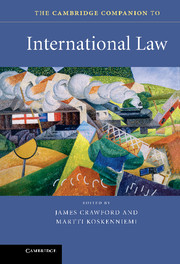Book contents
- Frontmatter
- Contents
- Preface
- Notes on contributors
- Introduction
- Part I The contexts of international law
- Part II International law and the state
- Part III Techniques and arenas
- Part IV Projects of international law
- 12 Constituting order
- 13 Legitimating the international rule of law
- 14 Human rights in disastrous times
- 15 Justifying justice
- 16 Regulating trade, investment and money
- 17 Divided against itself
- 18 Conserving the world’s resources?
- Guide to electronic sources of international law
- International law chronology
- Select guide to further reading
- Index
- References
18 - Conserving the world’s resources?
from Part IV - Projects of international law
Published online by Cambridge University Press: 05 July 2015
- Frontmatter
- Contents
- Preface
- Notes on contributors
- Introduction
- Part I The contexts of international law
- Part II International law and the state
- Part III Techniques and arenas
- Part IV Projects of international law
- 12 Constituting order
- 13 Legitimating the international rule of law
- 14 Human rights in disastrous times
- 15 Justifying justice
- 16 Regulating trade, investment and money
- 17 Divided against itself
- 18 Conserving the world’s resources?
- Guide to electronic sources of international law
- International law chronology
- Select guide to further reading
- Index
- References
Summary
Introduction
Central to the question of how we live is how we share the earth. From conflict over territory, to passage over the high seas, to the quest for raw materials, to disputes over water and oil, to dams and development, to methods of agriculture, food security and to negotiations over climate change, the question of resources lies at the heart of many international events. The struggle for the use, control and distribution of the earth and its riches has been the impelling force behind a great deal of international legal doctrine, including much which might, at first glance seem unrelated to that issue. From the River Oder case at the Permanent Court of Justice in 1929, to the judgments of the International Court in Corfu Channel in 1949 and the Gabčíkovo-Nagymaros Project case in 1997, many landmark decisions of international courts and tribunals, cited for a range of legal principles involving sources, jurisdiction, nationality, etc. involve at base disputes over scarce resources.
But if the struggle for control over resources lurks under the surface of international law, international law lies in the background of how we understand and define them in the first place. The idea of background reiterates the importance, highlighted by other chapters in this volume, of an appreciation of historical context in understanding international law. In this instance, the ‘background’ is closely connected to international law’s imperial origins (Anghie 2005; Chimni 1987).
- Type
- Chapter
- Information
- The Cambridge Companion to International Law , pp. 398 - 420Publisher: Cambridge University PressPrint publication year: 2012
References
- 4
- Cited by



